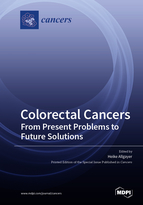Colorectal Cancers: From Present Problems to Future Solutions
A special issue of Cancers (ISSN 2072-6694).
Deadline for manuscript submissions: closed (30 November 2021) | Viewed by 41521
Special Issue Editor
Interests: cancer metastasis; translational research; tumor-associated proteases; microRNAs; molecular staging; gastrointestinal cancers
Special Issues, Collections and Topics in MDPI journals
Special Issue Information
Dear Colleagues,
Colorectal cancer is still one of the most frequent cancer entities in humankind. The scientific community has made significant progress in our molecular understanding of colorectal carcinogenesis, of hereditary as well as sporadic colorectal cancer types, this pertaining to the discovery of, e.g., (mutated) oncogenes and tumor suppressor genes, microsatellite instabilities, modifications in DNA repair, cellular aging, signaling cascades, genomic, epigenetic, transcriptional, translational, and protein modifications, as well as microbiotic factors and further parameters. Progression and metastasis have been more intensively studied especially during recent years, this leading to an intensified knowledge on molecular protagonists and microenvironmental interactions contributing to invasion, dissemination, and metastasis; still, more concerted efforts need to be made to better understand issues such as metastasis to different sites, or the metastatic heterogeneity of single cells. Nevertheless, based on actual discoveries, personalized medicine, together with highly interdisciplinary therapeutic strategies combining advanced levels of surgical techniques, oncology, and radiation in neoadjuvant, adjuvant, or palliative settings, has started to improve the clinical prognosis of individual patients with colorectal cancer. However, too many patients with this disease will still be diagnosed in too advanced stages, develop relapse and metastasis despite of modern interdisciplinary and personalized therapy advances, and finally die of this disease which still belongs to the top killer cancer entities in the World.
The present Special Issue will feature articles of different international experts with the latest data in the fields mentioned above. It will include novel hypotheses on molecular drivers of the disease, advanced ideas on cancer cell heterogeneity and its diagnosis, and discuss the latest model systems and advances in the translation of molecular knowledge into clinical studies. With this Special Issue, we aim to deepen discussions and ideas amongst colleagues in all kinds of disciplines working on this disease, and to intensify translational and interdisciplinary collaborations aimed at an ultimate understanding of strategies to defeat, and prevent, colorectal cancer and its progression
Prof. Heike Allgayer, MD, PhD
Guest Editor
Manuscript Submission Information
Manuscripts should be submitted online at www.mdpi.com by registering and logging in to this website. Once you are registered, click here to go to the submission form. Manuscripts can be submitted until the deadline. All submissions that pass pre-check are peer-reviewed. Accepted papers will be published continuously in the journal (as soon as accepted) and will be listed together on the special issue website. Research articles, review articles as well as short communications are invited. For planned papers, a title and short abstract (about 100 words) can be sent to the Editorial Office for announcement on this website.
Submitted manuscripts should not have been published previously, nor be under consideration for publication elsewhere (except conference proceedings papers). All manuscripts are thoroughly refereed through a single-blind peer-review process. A guide for authors and other relevant information for submission of manuscripts is available on the Instructions for Authors page. Cancers is an international peer-reviewed open access semimonthly journal published by MDPI.
Please visit the Instructions for Authors page before submitting a manuscript. The Article Processing Charge (APC) for publication in this open access journal is 2900 CHF (Swiss Francs). Submitted papers should be well formatted and use good English. Authors may use MDPI's English editing service prior to publication or during author revisions.
Keywords
- colorectal cancer
- (molecular) carcinogenesis
- progression
- metastasis
- (single) cancer cell heterogeneity
- models
- (targeted) therapy
- personalized medicine







